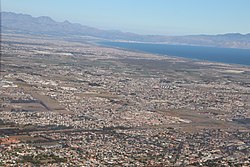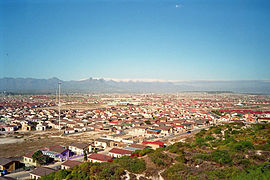Khayelitsha
| Khayelitsha | ||
|---|---|---|
|
|
||
| Coordinates | 34 ° 2 ′ S , 18 ° 41 ′ E | |
| Basic data | ||
| Country | South Africa | |
| Western cape | ||
| metropolis | City of Cape Town Metropolitan Municipality | |
| ISO 3166-2 | ZA toilet | |
| Residents | 391,749 (2011) | |
|
Special features: township |
||
|
Aerial photograph Khayelitsha (February 2018)
|
||
Khayelitsha is one of the largest townships in South Africa . It is located on the outskirts of Cape Town in the Cape Flats . Khayelitsha is the isiXhosa word for New Home.
In 2011, 391,749 people lived in Khayelitsha, around 98.5 percent of them black. IsiXhosa is the main language spoken in the township. It consists of houses built with public and private funds, as well as huts built with sheet metal, wood and cardboard.
The housing shortage in the western part of the Cape Province , especially in the greater Cape Town area, had increased sharply in the 1980s, which particularly affected the black population. According to official data from 1983, there were 5882 families on municipal waiting lists. According to other sources, there was a need for 19,000 families. With state funds, new residential buildings were built in Langa and Guguletu in 1982 . Because the demand could not be met, a new township settlement, Khayelitsha, with 1000 buildings and a financial volume of around 3 million rand was included in the settlement planning around 1983. The project development was in the hands of the National Housing Commission (NHC). A further 6 million rand were made available for the further expansion of Khayelitsha. The aim of the new township was to dissolve the Squatter settlement of Crossroads . The minister Piet Koornhof announced that the new district of around 2500 hectares will serve as a future residential area for 300,000 blacks and hoped for a voluntary move from other settlements. MP Ken Andrew ( PFP ) warned the minister that the proposed settlement would create problems. Black Sash , the Cape Housing Action Committee and the United Women's Organization expressed negative positions on these plans . The plans sparked unrest, as the forcible removal of other barracks settlements (such as the KTC camp) was announced, forcible expulsions to Transkei with the approval of their homeland government and the persecution of “illegal” settlers by the authorities. Helen Suzman (PFP) called the process "an ill-thought-out and useless way of tackling an obvious housing crisis". On February 15, 1985, Gerrit Viljoen , Koornhof's successor in office, announced that personnel and transport would now be provided to accelerate the preparations for the Crossroads move .
Khayelitsha was established in 1985 as a residential area for blacks from April 15 with the first resettlers from the Cathedral group (named after their protest action in St George's Cathedral in Cape Town) in Sector C of the new settlement. According to their leader Mali Hoza, that was 12,000 people. Previously, there had been consultations between government representatives and representatives of the Crossroads executive committee , which were considered to be important for the quietest possible situation. Nonetheless, there were riots in the course of which there was personal injury and the destruction of 28 police vehicles. By June 1985, 31,735 people had moved to Sector C. For the squatters without a work permit, the Blacks (Urban Areas) Consolidation Act of 1945 set a period of 18 months within which they were to find legal work and move to Khayelitsha. The relocation process and the previous disputes also generated differentiated views in the area of Crossroads . Leading actors from the Nyanga Bush squatter settlement rejected the previously agreed regulations for Crossroads , and wanted to receive approval for official residents in Khayelitsha before moving. They therefore asked for a meeting with Minister Gerrit Viljoen in order to be able to communicate their positions to him personally.
In the years after 2000, the government tried various campaigns to improve living conditions. That consisted of providing free water and electricity to all residents; There is also an intensive housing program , which is intended to reduce the number of shacks (barracks). However, there are long waiting lists for the newly built stone houses.
Khayelitsha served as the setting for an African version of the opera Carmen by Georges Bizet in the film adaptation of U-Carmen by British director Mark Dornford-May . People speak and sing in isiXhosa. The film won the highest award at the Berlinale 2005.
gallery
Barracks settlement on the N2 (2015)
Web links
- Michael von Aichberger: A visit to Khayelitsha . Photo report on www.aichberger.de




